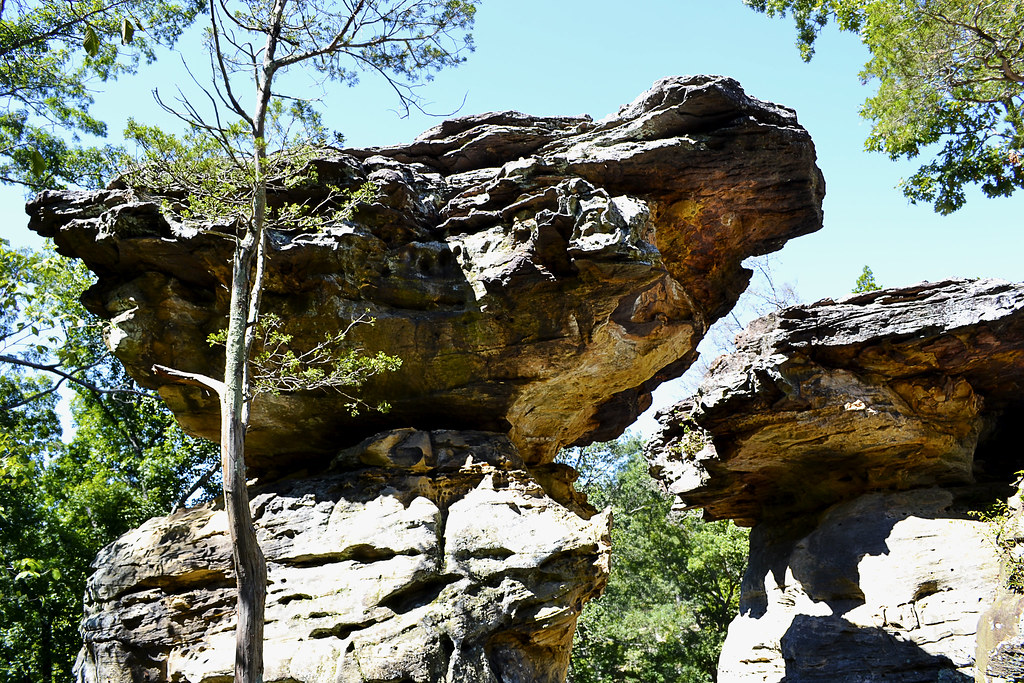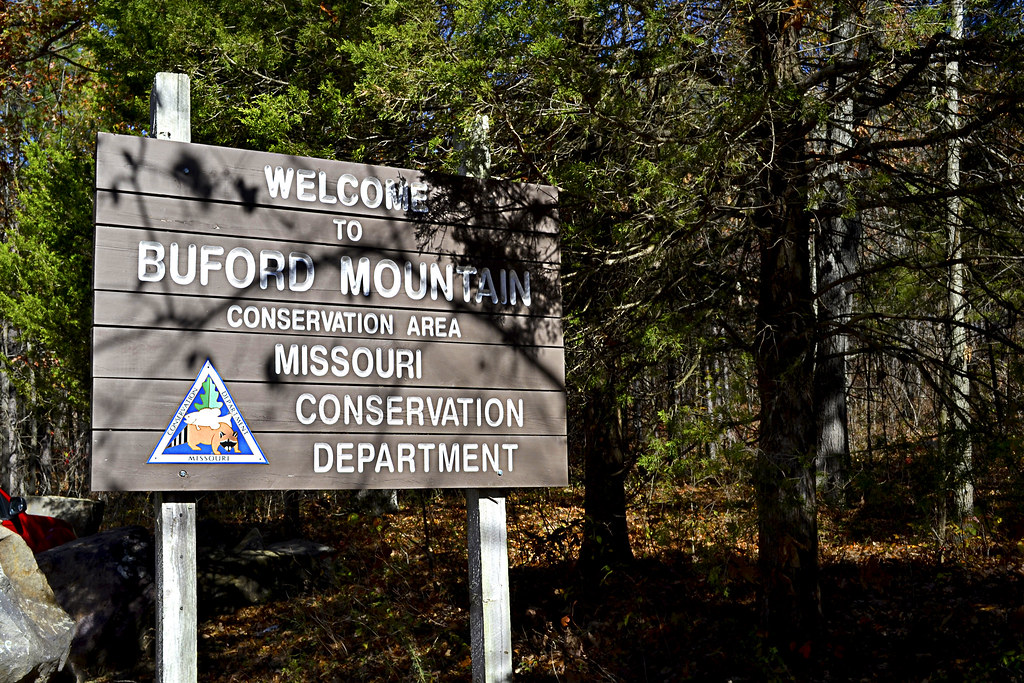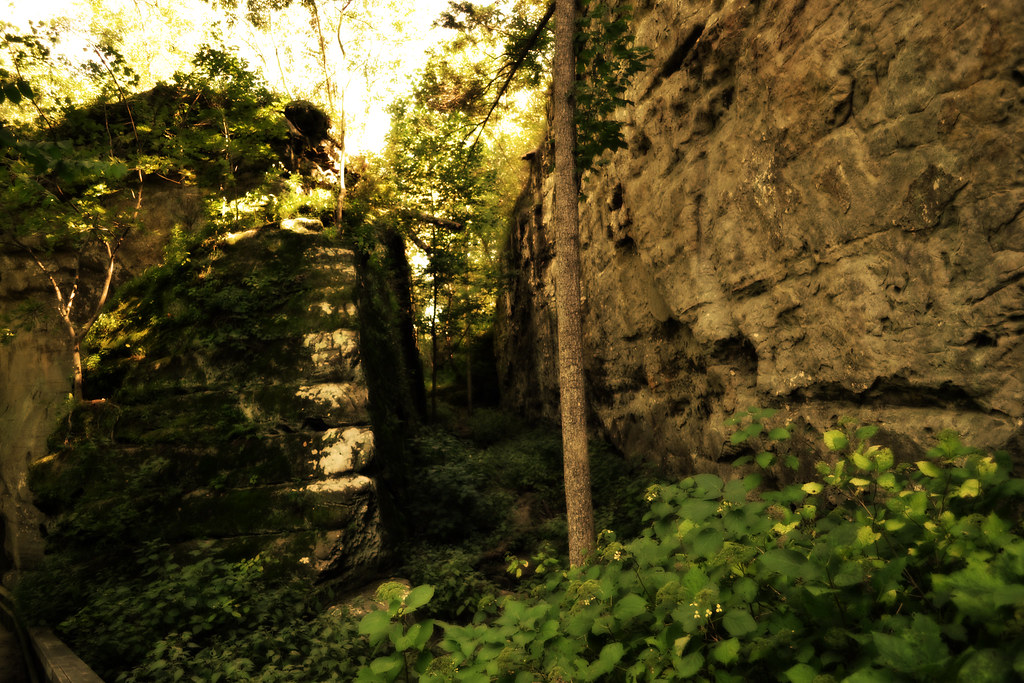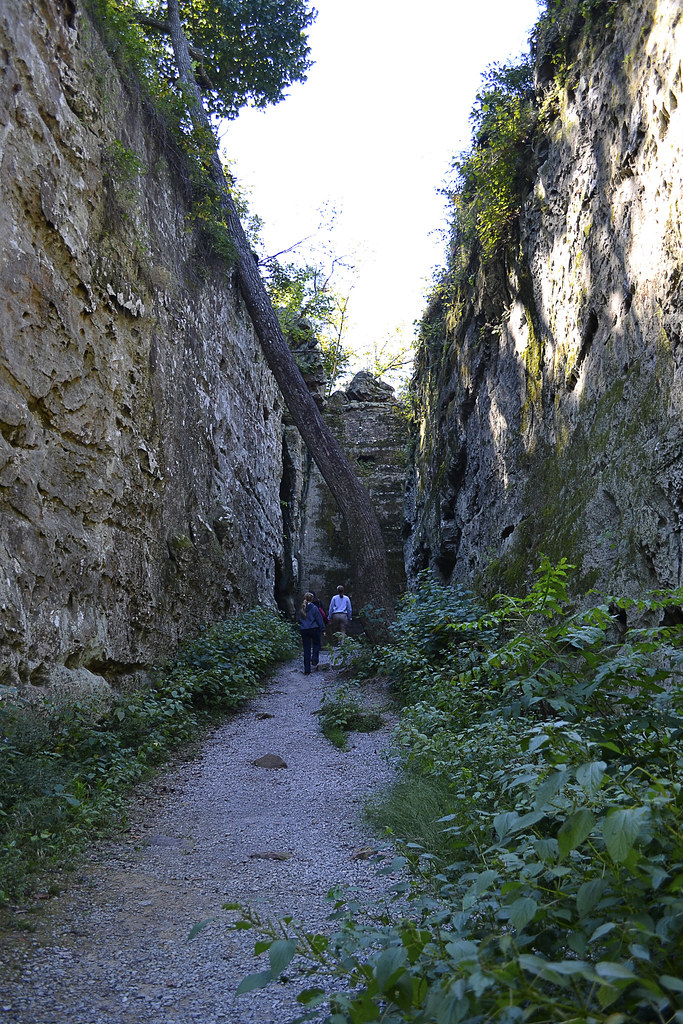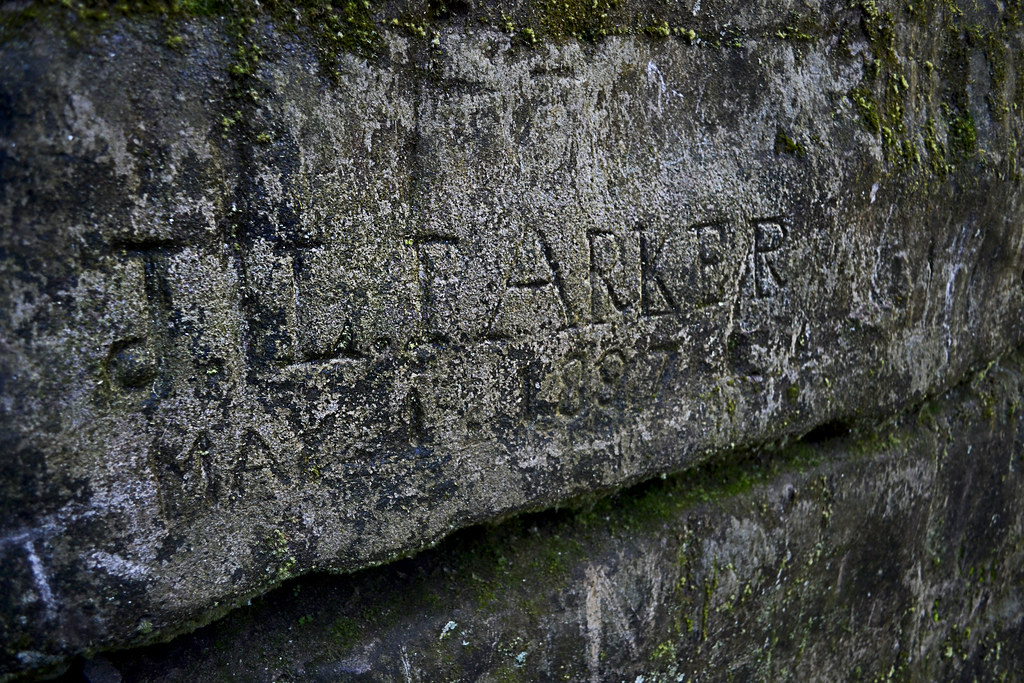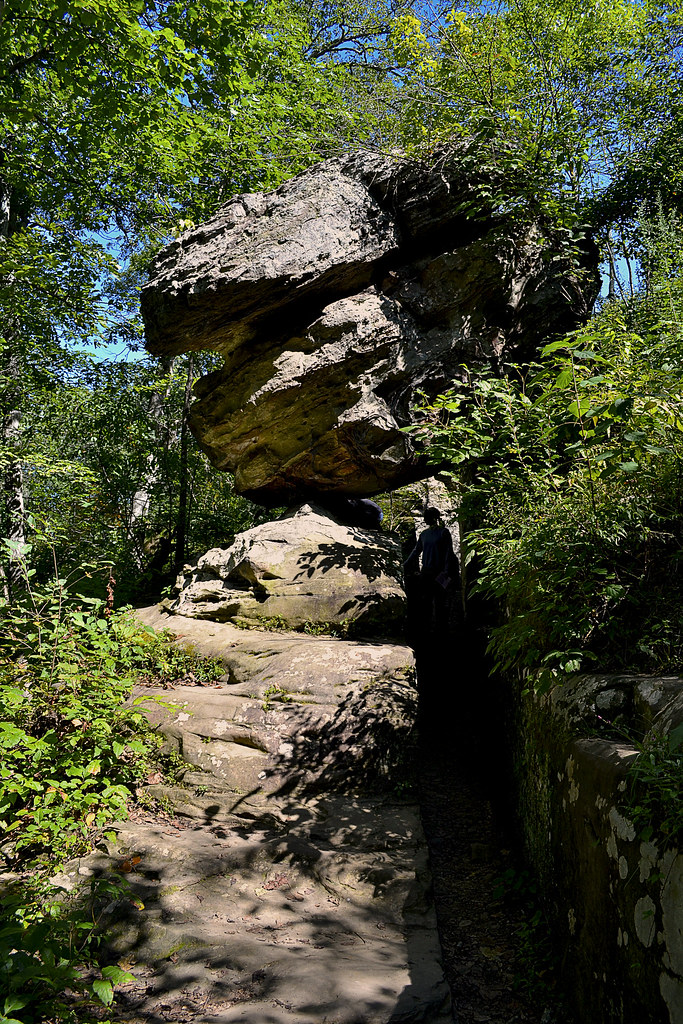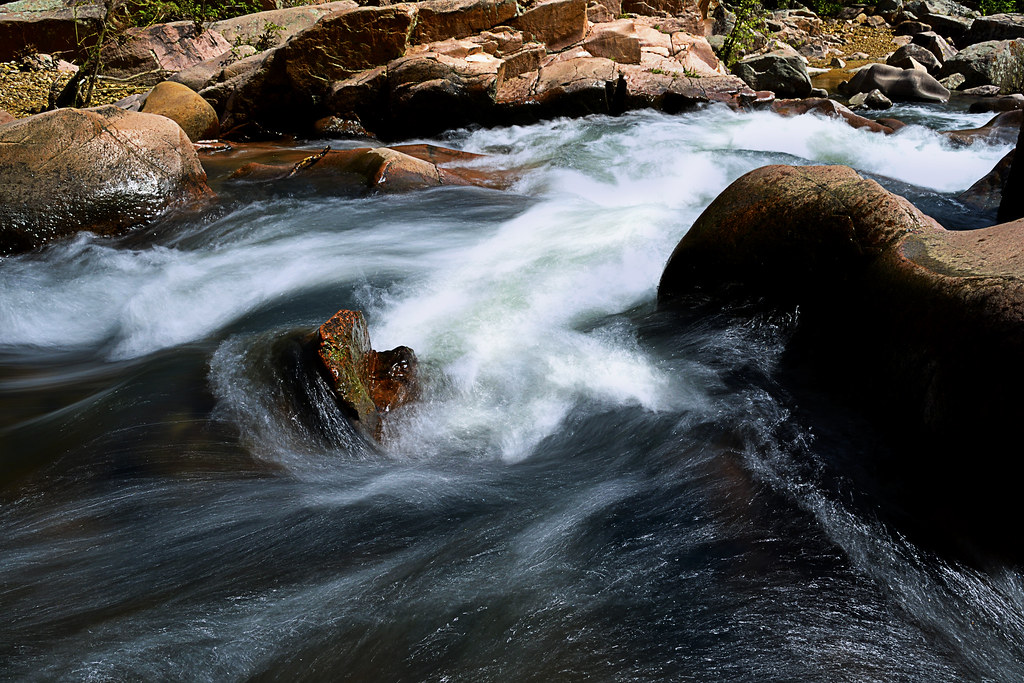In today's world it seems nearly everything moves fast and sometimes it may seem to move too fast. The week may speed by in a blur, leaving you to wonder... What did I do this week? What did I accomplish? Where are my keys? After a week like this, it's time to slow down. Way down. I just so happen to know that Buford Mountain Conservation Area is an extraordinary place to do it, and I will assure you, when you've finished the 10.6 mile loop you'll know what you did, what you accomplished, but your keys... Well, that's on you.
The (3rd) Top of Missouri: Big Buford
 |
| Keep an eye out for this low stone wall as you scale Big Buford. |
Buford Mountain Conservation Area is located just a few miles North of Ironton, Missouri off of the inconspicuous Route U. The mountain itself is actually more of a ridge, accentuated by a series of five high points along its spine. The first, and tallest point, on the trail has been nicknamed "Big Buford". As you climb its steep, rocky sides, keep an eye out for an old stone wall, evidence that early homesteaders laid claim to this area at one time, stone by stone. Big Buford peaks at 1740 feet above sea level, which happens to lay its claim to the 3rd highest peak in the state. How's that for a bit of an accomplishment? Hey, you didn't need any oxygen or Sherpas! Sure, not everyone may hold that to be a true Herculean feat, but I'll tell you what; after making the nearly 700 foot ascent to the wooded top of Big Buford over the winding rock and dirt surfaced trail, I'm pretty sure you'll feel a true sense of triumph. However, that sense of triumph may be slightly trumped by the fact that Big Buford is wooded, pretty heavily wooded in fact, and that makes for no sweeping vistas, no awe inspiring horizon to scan, no
I Can See for Miles and Miles (I love The Who, don't you?) moment. But wait... Just put The Who on pause for a moment, because your Miles and Miles view exists just a bit further down the trail at a place called Bald Knob.
The "Moonscape": Peak Two
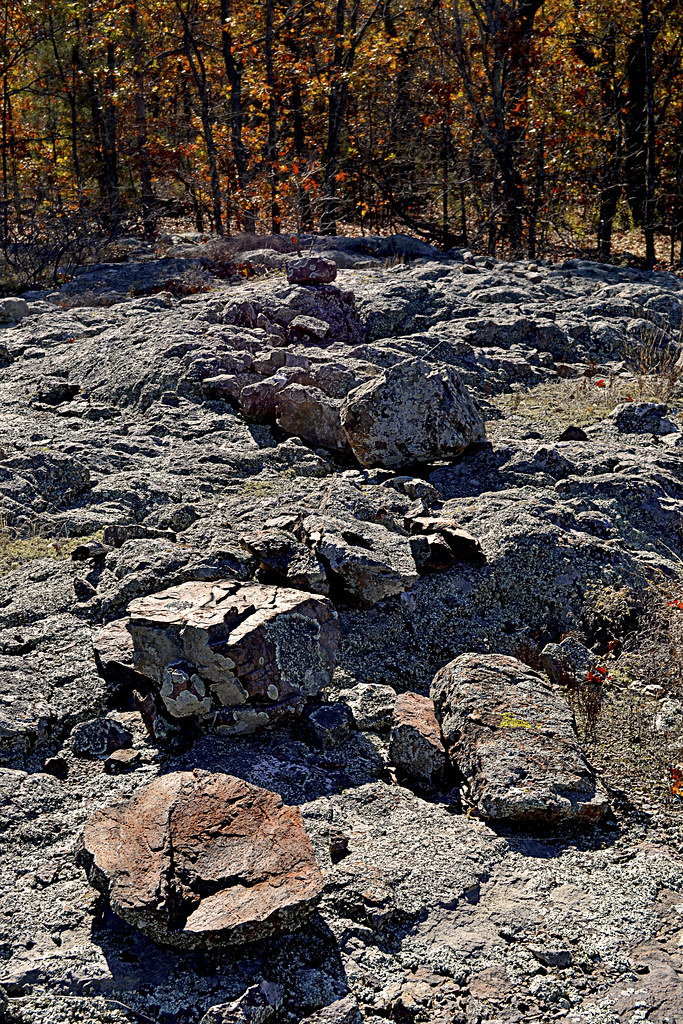
As you make your way toward the spectacular view at Bald Knob, you will first make your way over two more peaks and these aren't just "hike over" territory either. As you make your way down from Big Buford, keep your eyes open for the first of six wildlife watering holes which line this trail, placed there due to the lack of any real natural water source in the area. As the trail begins to once again gain elevation, you will find yourself near the second overall peak on the trail. It is here that the dense hardwood begins to make way for a very interesting formation of rock. It is here, at a touch over 1680 feet in elevation that the hardened granite stone of which the mountain is primarily composed of, known as ryholite, is completely exposed giving you access to your first encounter with one of a few "glades" located on the trail's route. It is this exposure that gave me a sense of what it must feel like to hike a bit on the moon, there is little vegetation, save for some lichen and moss growth upon the smooth stone floor, and I watched as the fall foliage, free from their tree moorings, swept across the desert like surface. I spent a few minutes here, one due to it being so beautifully stark and two... Well, I was a bit tired, that was two peaks one at 1740 and this one at 1680, in the span of about a mile.
The Fork: Peak Three

As you start descending from the "moonscape" second peak, you'll make your way past another wildlife watering hole and find yourself climbing back to around 1600 feet, by now I hope you've realized this trail is a quad burner. This third peak is similar to what you found at the top of Big Buford, a fairly heavily wooded peak with some large rocks scattered here and there. As you crest this third peak, you will soon find yourself at a fork in the trail that marks the beginning of the Buford Mountain loop. It is at this junction that you can continue left (Northwest) and head to Bald Knob or right (Northeast). Most visitors certainly bear on to the left trail and make their way toward the gorgeous view from Bald Knob, and that is the way I took. The trail is marked with directional arrows at this point too, although they may be somewhat obscured by forest growth. I'll be honest with you here as well, many hikers do not take the full 10.6 loop hike at Buford Mountain, many hike to Bald Knob and back, putting the total mileage at closer to 6.6 miles, which is still a pretty decent hike.
The View: Bald Knob
As you begin your climb up the fourth peak, you can begin to cue "Miles and Miles", because the forest canopy begins to quickly thin, and you enter another beautiful glade area as you near the top of Bald Knob. But, before you get to the official scenic overlook, you may find a less worn trail that leads off slightly to the West, following that faint trail led me to a wonderful appetizer of a view of the Belleview Valley below, complete with a small fire pit and boulders to perch upon. In fact, I thought I had stumbled upon the
official Bald Knob view here and took a TON of pictures, not realizing that the actual infamous vista was really a few more yards to the North.
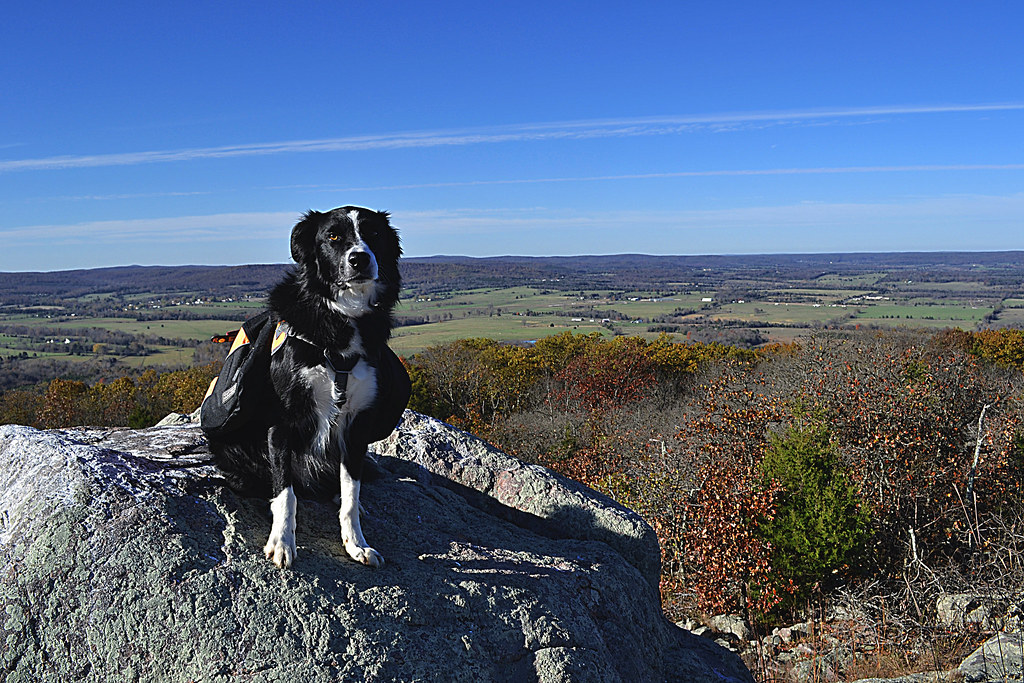
However, if you decide to stick to the main trail only, don't be worried, as you approach Bald Knob you will once again begin to
real Bald Knob overlook. It is at this overlook, at this time, no doubt with "Miles and Miles" playing softly through your earbuds, that you will be granted one heck of a view. A view that stretches over miles of the Belleview Valley will sprawl below you and if you've made this trek in late October you nay be treated with the brilliant fall pallet of oranges, reds, tans, and violets of the foliage. Quite simply THIS is the view you are looking for, and it is gorgeous. The overlook comes complete with a "posing" boulder, which will allow you to gain even a bit more elevation from which to survey your new kingdom from 1560 feet above sea level and maybe even snap a selfie or two. Even my hairy hiking buddy, Hyatt, had to get in on the view, he perched on the boulder, flashed me a toothy smile and I just had to take his picture...
see markers and signage. In fact, there is a
rather large sign, complete with arrow that directs you quite well to just the right spot to take it all in.
The Rest: Peak Five & The Valley
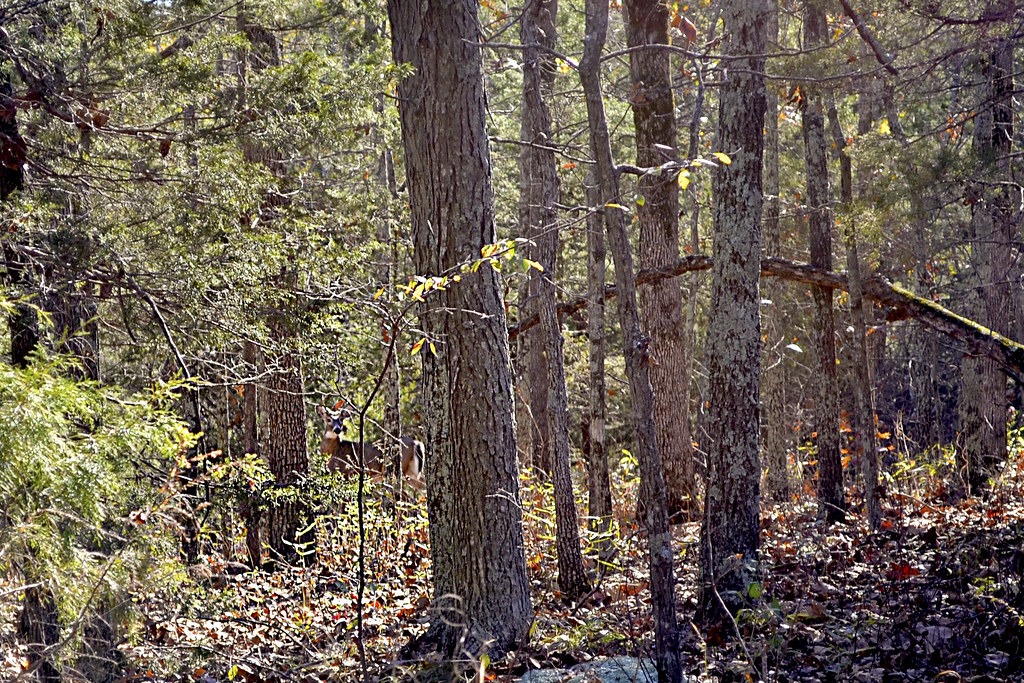 |
| Can you spot the 4-pointer? |
I'll be honest, after the view from Bald Knob the rest of the hike had a hard time keeping up. But honestly, I loved this hike. I had a hard time saying goodbye to the sweeping view offered at Bald Knob, but eventually made my way down the trail, passing another wildlife watering hole, and then back up to the fifth peak. At the top of peak five, many of the trees appeared dead, with brittle branches covered in lichens and moss, but the undergrowth was thick with many new saplings quickly reaching their way to the sun. I continued on and began to descend from the fifth peak and into the valley, which would comprise a good portion of the back side of the loop. As I neared the bottom, I was greeted by a large grove of cedars, and it was here that I nearly missed my turn to stay on the loop. There was a small arrow pointing to the East, but I missed it, luckily I caught a small break in identifying the trail seemed to split here. The odd thing about the split was that the "wrong" trail was better worn than the trail that continued the loop.
As I made my way through the valley, I concentrated on just taking it slow and taking it all in. Then, I came to notice a great deal of wildlife activity around me. Squirrels twittered at me from their lofty tree homes, I heard turkeys clucking in the distance and I was even lucky enough to happen upon a small four-point buck who was out grazing the plentiful acorns as noon neared. Which brings me to a quick warning, the MDC does allow hunting in this area, particularly hunting of squirrel, turkey and deer, so please be aware of any possible
Missouri hunting seasons as you may want to postpone your hike or tread a bit more carefully and brightly than usual at those times.
Directions:
More Information:
Local Treks on facebook
My Buford Mountain Flickr Album: More snaps from my hike through the area
Buford Mountain Conservation Area Summary Page: MDC Information
Buford Mountain Area Map: Provided by the MDC
Buford Mountain Area Information: Provided by the MDC
Google My Tracks Information:
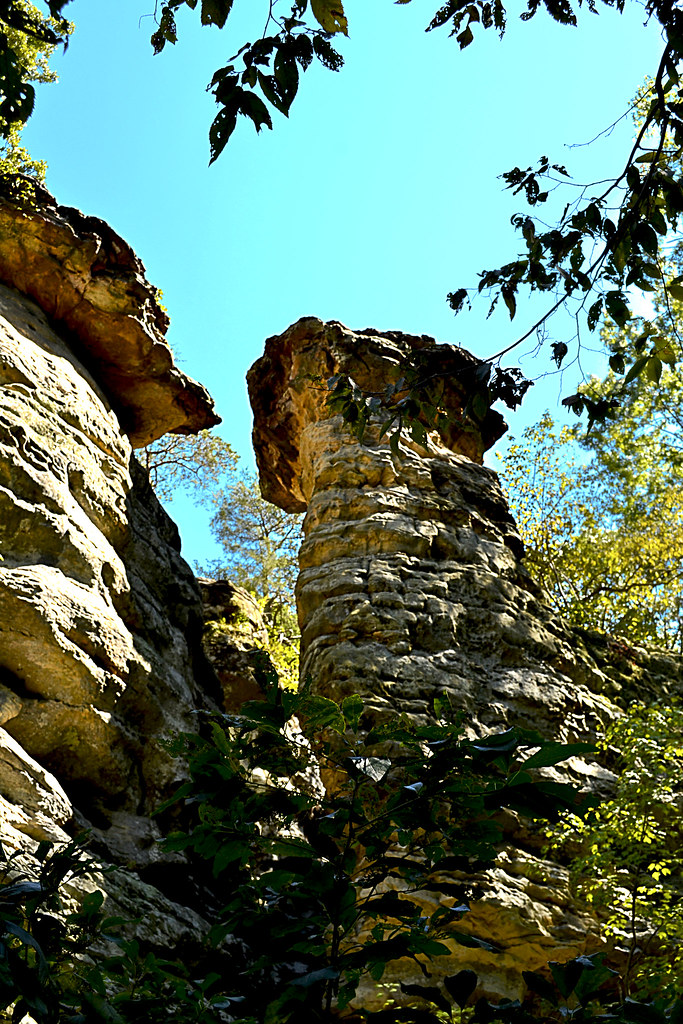 The official trail ended at a wonderful spot from which to gather a ground level view of the Devil's Standtable, but I wanted to get just a bit closer to this magnificent natural monument. Upon a bit of inspection I found a less worn trail that led to the sandstone base and quickly scrambled up the stoney incline. Let me tell you, at eye-level with the Devil's Standtable you'll surely be impressed with just how delicate the balancing of this formation is and just how fragile the difference between the Standtable staying perched upon its column or its possible plummeting from its lengthy perch! As always, I'll give warning here... Rock may become quite slippery when wet and there is always a possibility of slipping and falling while leaping, bounding, jumping, cartwheeling, flipping, climbing, sliding, handstanding or having any other type of fun on rocks. Children may also be able to get up into an area then be unable to come back down, so please always err on the side of safety.
The official trail ended at a wonderful spot from which to gather a ground level view of the Devil's Standtable, but I wanted to get just a bit closer to this magnificent natural monument. Upon a bit of inspection I found a less worn trail that led to the sandstone base and quickly scrambled up the stoney incline. Let me tell you, at eye-level with the Devil's Standtable you'll surely be impressed with just how delicate the balancing of this formation is and just how fragile the difference between the Standtable staying perched upon its column or its possible plummeting from its lengthy perch! As always, I'll give warning here... Rock may become quite slippery when wet and there is always a possibility of slipping and falling while leaping, bounding, jumping, cartwheeling, flipping, climbing, sliding, handstanding or having any other type of fun on rocks. Children may also be able to get up into an area then be unable to come back down, so please always err on the side of safety.